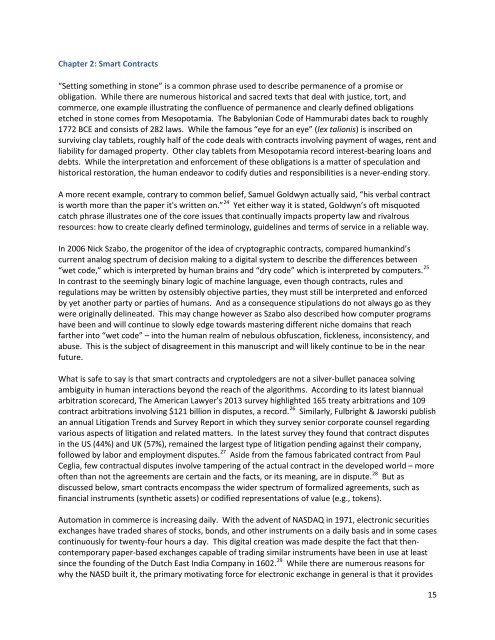Great+Chain+of+Numbers+A+Guide+to+Smart+Contracts,+Smart+Property+and+Trustless+Asset+Management+-+Tim+Swanson
Great+Chain+of+Numbers+A+Guide+to+Smart+Contracts,+Smart+Property+and+Trustless+Asset+Management+-+Tim+Swanson
Great+Chain+of+Numbers+A+Guide+to+Smart+Contracts,+Smart+Property+and+Trustless+Asset+Management+-+Tim+Swanson
Create successful ePaper yourself
Turn your PDF publications into a flip-book with our unique Google optimized e-Paper software.
Chapter 2: Smart Contracts<br />
“Setting something in stone” is a common phrase used to describe permanence of a promise or<br />
obligation. While there are numerous historical and sacred texts that deal with justice, tort, and<br />
commerce, one example illustrating the confluence of permanence and clearly defined obligations<br />
etched in stone comes from Mesopotamia. The Babylonian Code of Hammurabi dates back to roughly<br />
1772 BCE and consists of 282 laws. While the famous “eye for an eye” (lex talionis) is inscribed on<br />
surviving clay tablets, roughly half of the code deals with contracts involving payment of wages, rent and<br />
liability for damaged property. Other clay tablets from Mesopotamia record interest-bearing loans and<br />
debts. While the interpretation and enforcement of these obligations is a matter of speculation and<br />
historical restoration, the human endeavor to codify duties and responsibilities is a never-ending story.<br />
A more recent example, contrary to common belief, Samuel Goldwyn actually said, “his verbal contract<br />
is worth more than the paper it's written on.” 24 Yet either way it is stated, Goldwyn’s oft misquoted<br />
catch phrase illustrates one of the core issues that continually impacts property law and rivalrous<br />
resources: how to create clearly defined terminology, guidelines and terms of service in a reliable way.<br />
In 2006 Nick Szabo, the progenitor of the idea of cryptographic contracts, compared humankind’s<br />
current analog spectrum of decision making to a digital system to describe the differences between<br />
“wet code,” which is interpreted by human brains and “dry code” which is interpreted by computers. 25<br />
In contrast to the seemingly binary logic of machine language, even though contracts, rules and<br />
regulations may be written by ostensibly objective parties, they must still be interpreted and enforced<br />
by yet another party or parties of humans. And as a consequence stipulations do not always go as they<br />
were originally delineated. This may change however as Szabo also described how computer programs<br />
have been and will continue to slowly edge towards mastering different niche domains that reach<br />
farther into “wet code” – into the human realm of nebulous obfuscation, fickleness, inconsistency, and<br />
abuse. This is the subject of disagreement in this manuscript and will likely continue to be in the near<br />
future.<br />
What is safe to say is that smart contracts and cryptoledgers are not a silver-bullet panacea solving<br />
ambiguity in human interactions beyond the reach of the algorithms. According to its latest biannual<br />
arbitration scorecard, The American Lawyer’s 2013 survey highlighted 165 treaty arbitrations and 109<br />
contract arbitrations involving $121 billion in disputes, a record. 26 Similarly, Fulbright & Jaworski publish<br />
an annual Litigation Trends and Survey Report in which they survey senior corporate counsel regarding<br />
various aspects of litigation and related matters. In the latest survey they found that contract disputes<br />
in the US (44%) and UK (57%), remained the largest type of litigation pending against their company,<br />
followed by labor and employment disputes. 27 Aside from the famous fabricated contract from Paul<br />
Ceglia, few contractual disputes involve tampering of the actual contract in the developed world – more<br />
often than not the agreements are certain and the facts, or its meaning, are in dispute. 28 But as<br />
discussed below, smart contracts encompass the wider spectrum of formalized agreements, such as<br />
financial instruments (synthetic assets) or codified representations of value (e.g., tokens).<br />
Automation in commerce is increasing daily. With the advent of NASDAQ in 1971, electronic securities<br />
exchanges have traded shares of stocks, bonds, and other instruments on a daily basis and in some cases<br />
continuously for twenty-four hours a day. This digital creation was made despite the fact that thencontemporary<br />
paper-based exchanges capable of trading similar instruments have been in use at least<br />
since the founding of the Dutch East India Company in 1602. 29 While there are numerous reasons for<br />
why the NASD built it, the primary motivating force for electronic exchange in general is that it provides<br />
15


